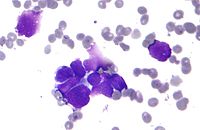
Photo from wikipedia
PurposeThe aim of this retrospective study was to evaluate the clinical outcome of a previously defined low-risk patient population with completely resected (R0) squamous cell carcinoma of the oral cavity, oropharynx,… Click to show full abstract
PurposeThe aim of this retrospective study was to evaluate the clinical outcome of a previously defined low-risk patient population with completely resected (R0) squamous cell carcinoma of the oral cavity, oropharynx, larynx (pT1–3, pN0–pN2b), hypopharynx (pT1–2, pN0–pN1), and the indication for postoperative radio(chemo)therapy.Patients and methodsAccording to predefined criteria, 99 patients with head and neck squamous cell carcinoma (SCC) who were treated at our institution from January 1, 2005 to December 31, 2014, were available for analysis. The Kaplan–Meier method was used for calculating survival and incidence rates. For univariate comparative analysis, the log-rank test was used for analyzing prognostic clinicopathologic parameters.ResultsMedian follow-up was 67 months. Cumulative overall (OS) and disease-free survival (DFS) were 97.9%/94.7%/88.0% and 96.9%/92.6%/84.7% after 1, 2, and 5 years, respectively. Cumulative incidence of loco-regional recurrence (LRR), distant metastases (DM), and second cancer (SC) were 1.0%/1.0%/4.9%, 0.0%/3.4%/5.8%, and 2.1%/4.2%/13.1%, respectively. In univariate comparative analysis, location of the primary tumor in the oropharynx was a significant predictor for increased OS (p = 0.043) and DFS (p = 0.048).ConclusionConsidering the low disease relapse rates and high rates of therapy-induced late side effects, as well as the increased risk of developing SC, a prospective multicentric trial investigating de-escalation of radiotherapy in this clearly defined low-risk patient population was started and is still recruiting patients (DIREKHT-Trial, NCT02528955).ZusammenfassungZielZiel dieser retrospektiven Studie war es, das klinische Outcome für ein ausgewähltes Niedrigrisiko-Patientenkollektiv nach stattgehabter vollständiger Resektion (R0) von Plattenepithelkarzinomen der Mundhöhle, des Oropharynx, Larynx (pT1–3, pN0–pN2b), Hypopharynx (pT1–2, pN0–pN1) und der Indikation zur postoperativen Radio(chemo)therapie zu ermitteln.Patienten und MethodenNach zuvor definierten Kriterien wurden 99 Patienten mit Plattenepithelkarzinomen im Kopf-Hals-Bereich, die sich vom 1. Januar 2005 bis 31. Dezember 2014 in unserer Klinik in Behandlung befanden, in die Auswertung einbezogen. Die Kaplan-Meier-Methode kam für die Berechnung der Überlebens- und Inzidenzrate zur Anwendung. Für die univariate Analyse wurde der Log-rank-Test zur Auswertung der prognostisch relevanten Parameter verwendet.ErgebnisseDas mediane Follow-up betrug 67 Monate. Das kumulative Gesamtüberleben (OS) und das kumulative krankheitsfreie Überleben (DFS) beliefen sich jeweils auf 97,9 %/94,7 %/88,0 % und 96,9 %/92,6 %/84,7 % nach 1, 2 und 5 Jahren. Die kumulativen Inzidenzen für das lokoregionäre Rezidiv (LRR), Fernmetastasen (DM) und das Zweitkarzinom (SC) betrugen jeweils 1,0 %/1,0 %/4,9 %, 0,0 %/3,4 %/5,8 % und 2,1 %/4,2 %/13,1 %. In der univariaten Analyse korrelierte die Primärtumorregion Oropharynx mit einem besseren OS (p = 0,043) und DFS (p = 0,048).SchlussfolgerungIn Anbetracht der niedrigen Rezidivraten, der hohen Spätnebenwirkungsraten und des erhöhten SC-Risikos wurde eine prospektive, multizentrische Studie initiiert, die die Deeskalation der Strahlentherapie bei diesem ausgewählten Niedrigrisiko-Patientenkollektiv untersucht und noch Patienten rekrutiert (DIREKHT-Studie, NCT02528955).
Journal Title: Strahlentherapie und Onkologie
Year Published: 2018
Link to full text (if available)
Share on Social Media: Sign Up to like & get
recommendations!